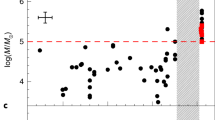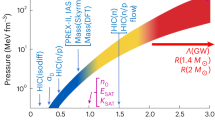Abstract
DETERMINATION of the mass distribution function of bodies is of prime importance for an understanding of the evolutionary processes that determine the population of the Solar System. We report here a method for measuring mass distribution of meteoroids, by determining the occurrence frequency of very brilliant fireballs. In a certain mass regime the number distribution can be described by a power law dn = (const.)m−s dm where dn is the number of particles having a mass between m and m+dm and s is the mass distribution index. s is a slowly varying function of mass, and values of s have been well established for meteoroid particles 10−12< m ≲ 101 g by various techniques, and reasonable estimates are available for large bodies m ≳ 105 g (meteorites and asteroids). There is, however, a lack of information in the mass range 101 ≲ m ≲ 105 g corresponding1 to meteoroids which yield meteors of visual magnitude − 2 ≳ Mv □ − 12 ranging from bright visual objects to very brilliant fireballs (the term fireball generally refers to any meteor brighter than Venus, Mv ≃ −4). The problem is one of sampling: while meteor (radar, visual, optical) counts over periods of hours at a single station are suitable for estimates of s for m ≲ 1 g (Mv ≳ 0), such a procedure yields a prohibitively low count for larger objects. This difficulty would be overcome by observing over a large area of the Earth's surface for many years. We determine here the occurrence frequency of very brilliant fireballs, as a method of s measurement. A fireball of magnitude equal to that of the full Moon is an outstanding spectacle likely to be well reported in an area with a high population density. With good communications and active research groups analysing reports and recording data, a reliable estimate of the influx of such large objects could be secured. In the British Isles, extensive records of fireball events covering more than 40 yr, are available2,3. Most observers' estimates were based on the great illumination produced on the landscape or inside buildings, and the personnel analysing the reports were experienced workers in the field. A detailed examination of the reports reveals a consistent rate of about two lunar fireballs (apparent visual magnitude equal to or brighter than that of the full Moon) seen in the British Isles per year. Specifically, in the period 1900–36 the average occurrence frequency was 2.4 yr−1. This frequency can be compared with that of visual meteors to obtain an estimate of s.
This is a preview of subscription content, access via your institution
Access options
Subscribe to this journal
Receive 51 print issues and online access
$199.00 per year
only $3.90 per issue
Buy this article
- Purchase on Springer Link
- Instant access to full article PDF
Prices may be subject to local taxes which are calculated during checkout
Similar content being viewed by others
References
Hughes, D. W. Mon. Not. R. astr. Soc. 166, 339–343 (1974).
Observatory 24–59(1900–36).
Mem. Br. astr. Ass. 32, part 1 (1936).
Millman, P. M. The Moon 8, 228–240 (1973).
Brooks, C. E. P. Mem. R. met. Soc. 1(10) 127–138 (1930).
Denning, W. F. Mon. Not. R. astr. Soc. 72, 423–451 (1912).
McKinley, D. W. R. Meteor Science and Engineering, 130 (McGraw-Hill, New York, 1961).
Author information
Authors and Affiliations
Rights and permissions
About this article
Cite this article
BAGGALEY, W. Mass distribution of massive meteoroids determined by occurrence of brilliant fireballs. Nature 266, 608–609 (1977). https://doi.org/10.1038/266608a0
Received:
Accepted:
Issue Date:
DOI: https://doi.org/10.1038/266608a0
Comments
By submitting a comment you agree to abide by our Terms and Community Guidelines. If you find something abusive or that does not comply with our terms or guidelines please flag it as inappropriate.



